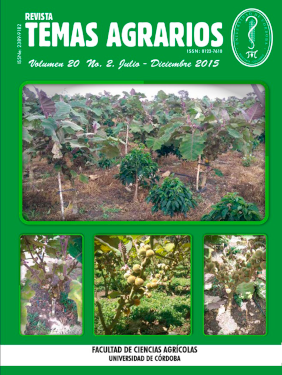Resistance to powdery mildew (Erysiphe polygoni) and yield on afila pea (Pisum sativum L.)
Resistencia a oídio (Erysiphe polygoni) y rendimiento en arveja afila (Pisum sativum L.)
How to Cite
Checa, O., & Rodríguez, M. (2015). Resistance to powdery mildew (Erysiphe polygoni) and yield on afila pea (Pisum sativum L.). Sour Topics, 20(2), 58-71. https://doi.org/10.21897/rta.v20i2.759
Dimensions
license

This work is licensed under a Creative Commons Attribution-NonCommercial 4.0 International License.
Show authors biography
Article visits 1725 | PDF visits
Downloads
Download data is not yet available.
- Checa, O. 2014. Investigación para el mejoramiento de la tecnología de producción de arveja (Pisum sativum L.) en el departamento de Nariño. En: http://www.ucc.edu.co/pasto/prensa/2014/Documents/1Resumen_Proyecto_L%C3%ADneas%20Arveja.pdf.;consulta:noviembre, 2014.
- Cruz, C. 2001. Programa GENES. Aplicativo computacional em genética e estadística.Editora UFV, Viϛosa MG.642p.
- Dane, 2011. Encuesta nacional agropecuaria. En http://apps.who.int/fctc/reporting/Checa et al. -party_reports/colombia_annex7_national_agricultural_survey.pdf.consulta : abril,2016.
- Falloon, R., Viljanen-Rollinson, S., Coles, G. and Poff, J. 1995. Disease severity keys for powdery and downy mildews of pea, and powdery scab of potato, New Zealand Journal of Crop and Horticultural Science 23(1): 31-37
- Giaconi, V. 2004. Cultivo de hortalizas. 15 ed. Santiago de Chile: Editorial Uversitaria. 120 p.
- Goldenberg, J. 1965. “Afia” a new mutation in pea (Pisum sativum L.). Boletín Genética1: 27-28.
- Gotschalk, w. 1964. Die wirkung mutierter gene auf di Morphologie und Funkcion pflnzlicher Organe, Botanische Studien.
- Gonzáles, M. 2001. Interacción genotipo x ambiente en guisante proteaginoso (Pisum sativum L.). Tesis doctoral. Universidad de Valladolid: Departamento de Producción Vegetal y Silvopascicultura. 272 p.
- Hedley, C. and Ambrose, M. 1981. Designing “leaflss” plants for improving the dried pea crop. Advances in Agronomy. 34:225 - 227.
- Instituto Técnico y de Gestión Agrícola de Navarra (ITGA). 2003. Guisante proteaginoso en Navarra, campaña 2003- 2004.12 p.
- Khan, T., Ramzan, G., Jillani, G. and Mehmood, T. 2013. Morphological performance of peas (Pisum sativum L.) genotypes under rainfed conditions of Potowar region. Journal of Agricutural Research. 51:51- 60.
- Kujala, V. 1953. Felderbse, beiwelcher die ganzBlattspreite in Ranken umgewandelt ist. Archivum.100 Societatis Zoologica e Botanica e Fennicae “Vanamo” 8:44 - 45.
- Ligarreto, M., Gustavo, A., Ospina, H. y Andrés, R. 2009. Análisis de parámetros heredables asociados al rendimiento y precocidad en arveja voluble (Pisum sativum L.) tipo Santa Isabel. Agronomía Colombiana 27(3):333 - 339.
- Marx, G. A. and Mishanec, W. 1962. Inheritance of ovule number in Pisum sativum. Proc. Amer. Soc. Hort. Sci. 80: 462-467.
- Marx, G. and Mishanec, W. 1967. Further studies on the inheritance of ovule number in Pisum. Crop Science 3:236- 239.
- Marx, G. 1987. A suite of mutants that modify pattern formation in pea leaves. Plant Molecular Biology Reporter 5:311 - 335.
- Pantoja D., Muñoz K. y Checa O. 2014. Evaluación y correlación de componentes de rendimiento en líneas avanzadas de arveja Pisum sativum con gen afila. Revista de Ciencias Agrícolas 31 (2): 24- 39.
- Mera, M., Levío, J., Alcalde, J., Morales, M. y Galdames, R. 1996. Brisca-INIA, primera variedad de arveja áfia obtenida en Chile. Agricultura Técnica (Chile) 56 (4):282 - 286.
- Mihailovic, V. 2008. Componentes de rendimiento de grano afia (af) líneas de guisantes forrajeros (Pisum sativum L.). Instituto de Cultivos y Hortalizas, NoviSad, Serbia. 98 p.
- Ondrej, M., Dostalová, R., Hybl, M., Odstrcilová, L., Tyller, R. and Trojan, R. 2003. Utilization of afia types of pea (Pisum sativum L.) resistant to powdery mildew (Erysiphe pisi DC.) in the breeding programs. Plant Soil Environ. 49 (11): 481-485
- Prohens, J. and Nuez, T. 2007. Vegetables II: Liliaceae, Solanaceae, and melliferae. Springer Science and Bussines Media. Handbook of plant breeding. Springer. New York. 365 p.
- Sañudo, B., Checa, O. y Arteaga, G.1999. Manejo agronómico de leguminosas en zonas cerealistas. Universidad de Nariño, Facultad de Ciencias Agrícolas. Colombia, Pasto. p49- 65.
- Singh, M., Hari, D. and Bisth, S. 2013. Genetic and genomic resources of grain legume improvement. First edition. ELSEVIER INSIGHTS. London. 322 p.
- Tamayo, J. 2000. Enfermedades del cultivo de la arveja en Colombia: Guía de reconocimiento y control. Boletín técnico. Fondo Nacional de Leguminosas. Bogotá, Colombia. 50 p.
- Tiemerman, V., Mills, G., Frew, T., Butler, T., Mccallum, J., S., Murray, C., Whitfild, A., Rusell, A. and Wilson, D. 2004. Linkage mapping of QTLs for seed yield, yield components and developmental traits in pea (Pisum sativum L.). En: 4th International Crop Science Congress. Brisbane, Australia.
- Tulcán, G. y Castillo, C. 1998. Efecto de la labranza y aplicación de herbicidas en el manejo de malezas en el cultivo de arveja (Pisum Sativum L.) en el municipio de Pasto departamento de Nariño. Tesis Ingeniero Agrónomo. Universidad de Nariño: Facultad De Ciencias Agrícolas. Área Agronomía.
- Wang, F., Fu, J., Dong, L., and Zhu, Y. 2003. Tendril inheritance in semi-leaflss pea and its utilization in breeding. Yi chuan=Hereditas/Zhongguo yi chuan xue huibian ji, 25(2), 185-188.




















